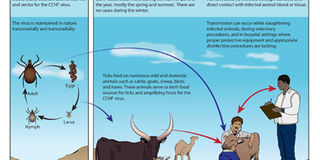Prime
49 people isolated as Crimean Congo Fever hits Lyantonde

This graphic illustration by CDC shows the life cycle of the Crimean-Congo haemorrhagic fever virus. Hard ticks are both a reservoir and vector for the CCHF virus.
What you need to know:
- The symptoms are sudden onset of fever, general body weakness, headache severe pain in limbs, bloody diarrhoea and bleeding from body openings.
- Last year, eight people in Lyantonde District died after presenting similar symptoms, but government did not confirm whether it was CCHF or any other Haemorrhagic fevers.
One person has been confirmed dead and 49 others currently are isolated following an outbreak of Crimean-Congo Haemorrhagic Fever (CCHF) in Lyantonde District.
According to the Lyantonde District Health Officer, Dr Moses Nkanika, Vincent Bayinda, 42, who was a businessman dealing in cattle, succumbed to the deadly disease on Wednesday.
“The blood samples we got from the deceased in Kasagama Sub County have tested positive for CCHF not Ebola as earlier suspected,” Dr Nkanika told Daily Monitor in an interview on Saturday morning.
He said 49 residents who got in close contact with the deceased are currently isolated to avoid contacts with other people as health workers continue to monitor their health conditions.
“These people are expected to remain in isolation for 40 days until they are cleared by ministry of health,” he said. He advised residents to be on alert and report any emergencies to the nearby health centres.
Mr Emmanuel Ainebyoona, the Ministry of Health spokesperson said he was not aware of the outbreak, but promised to crosscheck with other responsible authorities to confirm.
“What I know the first samples had tested negative for all those viral haemorrhagic fevers (VHFs), but I am going to verify and get back to you,” he said.
According to World Health Organisation (WHO), CCHF is caused by Bunya virus. It is transmitted by tick bites, contact with infected animal blood or tissues, and person-to-person transmission via blood, body fluids and semen.
The symptoms are sudden onset of fever, general body weakness, headache severe pain in limbs, bloody diarrhoea and bleeding from body openings.
Last year, eight people in Lyantonde District died after presenting similar symptoms, but government did not confirm whether it was CCHF or any other Haemorrhagic fevers.



